American democracy has often been described as a sham but rarely as shambolic. The US political system stands accused (at home and abroad) of producing an ossified two-party structure and election campaigns which are too long, vacuous and expensive to offer a meaningful choice to citizens. Further proof, at least to reformers, of the profoundly unsatisfactory character of US politics, is the pitiful levels of turnout recorded even for presidential contests. This year an estimated 51 per cent of Americans headed towards the polls, a slight improvement on 1996 but miserable by international standards.
Most of these complaints are not, however, constitutional in nature. They are charges levelled against specific features of current politics which are not necessarily permanent fixtures. The constitution did not create the Republican and Democratic parties-and besides, two-party systems are hardly unique to North America. The constitution did not mandate lengthy campaigns, nor did it raise Jay Leno, David Letterman, or any other television talk-show host to their present exalted status. The constitution does not oblige presidential elections to cost billions of dollars, nor does it actively discourage adults from exercising their franchise. The constitution does, though, make the electoral college the critical device for determining presidential elections. It is for this reason that the great debacle of 2000 is so important. The recounts and court challenges in Florida only matter because they may ensure that a presidential candidate secures the White House with fewer votes than his main rival. That outcome confronts the US with a crisis of political legitimacy unknown for more than a century.
It cannot be said that we have not been warned. The electoral college came within a whisker of producing a deviant result in 1916 (had it done so, the US might not have entered the first world war), 1960, 1968 and 1976. After every near miss, part of the political class called for change. The same will happen when the new Congress assembles in January. But if history and politics are any guide the prospects for reform will be disturbingly modest. The US will remain burdened by an electoral system that is patently antiquated and contains the innate possibility of producing results which strain legitimacy-a model only for the Mugabe school of democracy.
The process of amending the US constitution is institutional torture. Any proposal must first be introduced into the House of Representatives and obtain the support of two-thirds of members present. It then travels to the Senate, where the same margin is required for further progress. If it emerges alive from Capitol Hill the legislation heads for the state legislatures. Three-quarters of states must award their approval before an amendment can be considered ratified and valid. There have been some 700 past attempts at removing or adjusting the electoral college. All but one of these failed to cross the first hurdle. The fate of the one that did is instructive.
This attempt at reform was not triggered, as one might have expected, by the 1960 election, when John Kennedy defeated Richard Nixon in deeply murky circumstances; but by the 1968 contest, in which Nixon emerged by a small but clear margin over Hubert Humphrey, his Democratic opponent, and Governor George Wallace of Alabama-nominally a Democrat, but in this battle an independent advancing the cause of segregation. Wallace had run for president in the explicit hope of throwing the electoral college into confusion. The governor calculated that he might win enough electoral college votes by sweeping states in the deep south to hold the balance of power if Nixon and Humphrey ran evenly, as was anticipated, in the rest of the country. He would then be in a position to force policy concessions from one candidate (presumably Nixon) in return for his support in the electoral college. This seemed the most plausible route for a southern reactionary to halt the process of racial integration.
This strategy was coherent and almost worked, to the horror of mainstream politicians. A cross-party consensus emerged in the House of Representatives that only a shift towards a national popular vote could prevent the same strategy being used on a regular basis. On 18th September 1969, the House passed by a 339-70 majority an amendment which would have abolished the electoral college outright and replaced it with a simple direct election based on the popular vote, subject to the proviso that if the winner could not take 40 per cent or more of the popular vote then a run-off election between the two leading candidates would be held shortly afterwards.
This proposal went into a Senate committee, where it was quietly strangled. Much the same will probably happen with any reform next year as well. The subtle but effective political secret at work is that the Senate cannot challenge the electoral college without undermining its own legitimacy. The college operates on two basic principles; the critical importance of the state as the determinant unit in US political life, and disproportionality (smaller states are overrepresented within the college compared with their proportion of the entire US population). The Senate is constructed on the same two principles but with even greater distortion.
It has always surprised me that the structure of the Senate has not caused more political controversy as American democracy has developed. Even by the standards of federal systems (which have to deviate from pure proportionality in their upper chamber to work), the US Senate is a real curiosity. The 16 senators from the eight largest states represent between them slightly more than half of the American population. The votes of these individuals can be cancelled out by the 16 senators from the eight smallest states, who between them represent little more than 2 per cent of the entire population. The sort of contortions that the electoral college might produce once or twice a century thus occur in the Senate during each congressional session. There are literally thousands of examples of laws supported or opposed by senators representing a substantial minority of the population becoming law or not, regardless of the preferences of those who represent the majority.
This problem did not matter much in the 19th century, when the House of Representatives was the dominant of the two chambers and the Senate played a role in the US similar to that played at the same time by the House of Lords. But with the introduction of universal direct election in 1913, the Senate has become a far more influential institution. If pushed, one might even describe it as the senior partner. Members of the House of Representatives, after all, leave that office to run for the Senate and not vice versa.
In the improbable event that the Senate does surrender on this issue then the states themselves would need to be squared. And despite the damage inflicted to the standing of US democracy by the current system, the argument advanced 40 years ago by the then Senator John F Kennedy would surely prevail: "The electoral votes belong to each state. The way the systems works now is that we carry out a campaign in 50 states, and the electoral votes of the state belong to that party which carries each state. If we are going to change that system, we would strike a blow at states' rights... and make this country one great unit." It does not seem to have disturbed the future president that the same logic could have been used to support the right of southern states to secede in 1860. n












